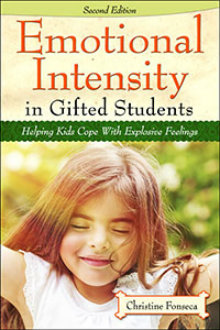Helping Gifted Kids Cope with Intensity
Emotional Intensity in Gifted Students: Helping Kids Cope With Explosive Feelings (2nd Edition)
By Christine Fonseca
(Prufrock Press, 2016 – Learn more)

Oftentimes the word “gifted” becomes synonymous with “independent” or “self-sufficient” or “smart.” Perhaps the best synonym for “gifted,” as Christine Fonseca’s book explains, is “intense.”
The same characteristic intensity that can cause a student to perform well on tests and ask probing, abstract questions can also bring about less desirable behaviors in the classroom and at home. Fonseca encourages students to embrace their intensities as part of who they are while giving parents and students coping strategies and coaching approaches.
Not all gifted students perform well in the classroom

- They can get bored with repetitive tasks and stop doing them (p. 5)
- They can refuse to do work if they don’t see value in the subject (p.17)
- They can shut down over open-ended school tasks (p. 25)
- They can have a difficult time with self-management of overexcitabilities, leading to excessive talking or movement in the classroom (p. 35)
- They can have learning disabilities that can be difficult to spot due to giftedness (p.51)
- They can face cases of perfectionism, where they stop handing in homework out of fear that the homework isn’t perfect (p. 157)
- They can get frustrated if the work doesn’t come easily to them and start to question themselves (p.161)
Through anecdotes about three composite fictional characters and through a “Notes to the Teacher” section, Fonseca gives some strategies for working through each of these situations.
Gifted learners need emotional education
Because gifted students can lead emotionally intense inner lives, it is important to teach these students how to express their feelings to others.
First, make sure students have vocabulary to describe how they feel. For example, a student’s family has agreed upon the word “spinning” to describe repetitive negative thinking (p. 81). Once there is buy-in from the students and adults as to how to describe emotional behavior, it is easier to identify.
The next step is to identify patterns that might lead up to an emotional outburst. If a student can identify his or her pre-outburst signs, whether they be a quicker pulse, shorter breathes, or even scratching palms, they will be better able to recognize that an outburst is on its way and may be able to implement a “cool down” technique.
The third step is to debrief with students and reflect on what caused the behavior and what changes might be made next time.
Fonseca provides easy “worksheets” and lists of questions to guide parents and teachers through each of these steps.
Use a coaching – not a compliance – approach
Fonseca explains that a compliance-based approach that gives rewards and consequences based on following rules, such as deductions for missing homework, are not likely to be successful with gifted learners. Instead, she advocates a coaching approach to supporting students. A good coach takes on these roles:
- As an active listener, a coach asks questions, helps identify facts, and listens to nonverbal cues.
- As a facilitator, the coach asks reflective questions to encourage decision-making over emotional reflexes (“Why was this a poor choice?” “What other choices could you have made?” “What might have happened if you had made that choice?”) and remains emotionally detached to model a rational decision-making process.
- As an inspirational guide, the coach identifies challenges as growth opportunities and helps a child see learning opportunities in the inevitable setbacks.
A useful guide for all learners, not just those who identify as gifted
Parents and teachers may find the plentitude of model dialogues with students, the analysis of where the dialogue went wrong, and the examples of improved conversations helpful in a variety of contexts with a variety of learners.
This book’s simple-to-use strategies and breakdowns of common school and home-based issues also make it a strong choice for a PTA book club read.
Amy Estersohn teaches middle school English in New York. When she’s not reading, reviewing, or tweeting (@HMX_MsE), she is keeping up with her various book clubs or doing research on what she should read next.



































